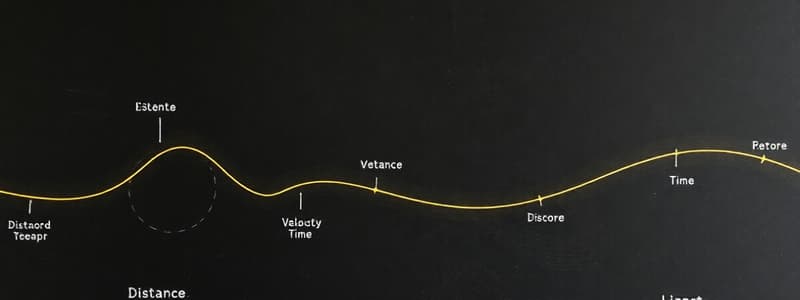Podcast
Questions and Answers
What does the slope of a distance-time graph represent?
What does the slope of a distance-time graph represent?
- Acceleration
- Distance
- Speed (correct)
- Time
Which type of graph shows a change in speed over time?
Which type of graph shows a change in speed over time?
- Distance-time graph
- Speed-time graph
- Acceleration-time graph (correct)
- Velocity-time graph
If an object is accelerating at a constant rate, what would the graph representing this look like?
If an object is accelerating at a constant rate, what would the graph representing this look like?
- A curved line increasing in steepness
- A straight horizontal line
- A straight vertical line
- A straight diagonal line (correct)
How would an object moving with a greater acceleration be represented on a velocity-time graph compared to one with less acceleration?
How would an object moving with a greater acceleration be represented on a velocity-time graph compared to one with less acceleration?
In what case would a velocity-time graph show a horizontal line?
In what case would a velocity-time graph show a horizontal line?
What does a flat line on a speed vs. time graph indicate?
What does a flat line on a speed vs. time graph indicate?
What is the acceleration for B based on the provided values?
What is the acceleration for B based on the provided values?
How is acceleration defined?
How is acceleration defined?
What is the acceleration of A according to the given data?
What is the acceleration of A according to the given data?
Which statement about acceleration is true?
Which statement about acceleration is true?
Flashcards
Distance-Time Graph
Distance-Time Graph
A graph that shows the relationship between distance traveled and the time taken.
Constant Acceleration Graph
Constant Acceleration Graph
A straight line on a velocity-time graph. The slope of the line represents the constant rate of change in velocity.
Velocity-Time Graph
Velocity-Time Graph
A graph that displays the connection between velocity and time. A straight line indicates uniform acceleration.
Acceleration
Acceleration
Signup and view all the flashcards
Deceleration
Deceleration
Signup and view all the flashcards
Slope on Speed-Time Graph
Slope on Speed-Time Graph
Signup and view all the flashcards
Constant Speed on Speed-Time Graph
Constant Speed on Speed-Time Graph
Signup and view all the flashcards
Calculate Acceleration
Calculate Acceleration
Signup and view all the flashcards
Study Notes
Distance-Time Graphs
- Graphs plotting distance against time show motion.
- Time is plotted on the x-axis (horizontal).
- Distance is plotted on the y-axis (vertical).
- A horizontal line on a distance-time graph indicates no movement (at rest).
- A diagonal line shows constant speed.
- A steeper line represents a higher speed.
- Curved lines indicate acceleration (speed is changing).
Speed vs Velocity
- Speed is the rate of motion, focusing on the magnitude.
- Velocity is speed with direction included.
- Example: 20 m/s is speed; 20 m/s east is velocity.
Speed Graphs: Distance-Time
- Time increasing to the right on a graph means time increases.
- Distance increasing vertically on the graph means distance increases from the starting point.
- Constant speed is represented by a straight line.
- Non-moving objects have a horizontal line.
- Steeper lines represent higher speeds.
Acceleration Graphs: Velocity-Time
- Acceleration is the rate of change of velocity.
- In a velocity-time graph, the gradient (slope) of the line equals the acceleration.
- A flat line indicates no acceleration (constant velocity).
- An upward curving line represents increasing acceleration.
- A downward curving line represents decreasing acceleration or deceleration.
- A negative gradient indicates deceleration.
Analyzing Acceleration Graphs
- Graphs showing acceleration and deceleration will have different shapes.
- Using graphs to analyze motion shows constant acceleration, deceleration, increasing/decreasing acceleration, or no acceleration.
- The slope of a line on a graph shows acceleration.
Studying That Suits You
Use AI to generate personalized quizzes and flashcards to suit your learning preferences.




